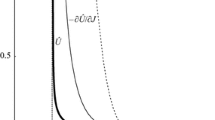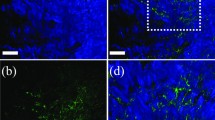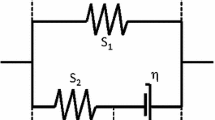Abstract
The purpose of this study is to describe interstitial fluid flow in axisymmetric soft connective tissue (ligaments or tendons) when they are loaded in tension. Soft hydrated tissue was modelled as a porous medium (using Darcy’s Law), and the finite element method was used to solve the resulting equations governing fluid flow. A commercially available computer program (FiDAP) was used to create an axisymmetric model of a biomechanically tested rat ligament. The unknown variables at element nodes were pressure and velocity of the interstitial fluid (Newtonian and incompressible). The effect of variations in fluid viscosity and permeability of the solid matrix was parametrically explored. A transient loading state mimicking a rat ligament mechanical experiment was used in all simulations. The magnitude and distribution of pressure, stream lines, shear (stress) rate, vorticity and velocity showed regular patterns consistent with extension flow. Parametric changes of permeability and viscosity strongly affected fluid flow behaviour. When the radial permeability was 1000 times less than the axial permeability, shear rate and vorticity increased (approximately 5-fold). These effects (especially shear stress and pressure) suggested a strong interaction with the solid matrix. Computed levels of fluid flow suggested a possible load transduction mechanism for cells in the tissue.
Similar content being viewed by others
Abbreviations
- b :
-
inertial coefficient
- C:
-
coupling matrix
- f :
-
body force
- F:
-
force/force vector
- \(\bar K\) :
-
diffusion matrix related to permeability
- K :
-
permeability matrix
- K z :
-
permeability in the longitudinal direction
- K r :
-
permeability in the radial direction
- L :
-
length of analytical model
- ΔL :
-
length change of analytical model
- M:
-
mass matrix
- p:
-
nodal pressure or pressure vector
- P:
-
fluid pressure
- r:
-
radial axis
- R :
-
radius of analytical model
- ΔR :
-
radial change of analytic model
- t:
-
time
- T :
-
matrix transformation
- u:
-
displacement
- ν:
-
fluid velocity
- V:
-
velocity/volume vector
- V r :
-
velocity in radial direction
- V z :
-
velocity in longitudinal direction
- V f :
-
fluid volume
- z :
-
longitudinal axis
- ϕ:
-
medium porosity
- η:
-
fluid viscosity
- ρ:
-
fluid density
- ∇:
-
Nabla operator (gradient/divergence)
- ϖ:
-
partial derivative
- −:
-
overline; average symbol of variable
- ⊙:
-
time rate of change
- m :
-
power index
References
Bear, J. (1972): ‘Dynamics of fluids in porous media,’ (Elsevier Publishing Company, New York)
Chen, C., McCabe, R. P. andVanderby, R. (1995): ‘Two electrokinetic phenomena in rabbit patellar tendon: Pressure and voltage,’ ASME Bioengineering Conference,29, pp. 31–32
Ghaboussi, J. andWilson, E. L. (1973): ‘Flow of compressible fluid in porous elastic media,’Int. J. Num. Meth. Eng.,5, pp. 419–442
Greenkorn, R. A. (1983): ‘Flow Phenomena in Porous Media’ (Marcel Dekker, Inc., New York)
James, N. L., Harrison, D. G. andNerem, R. M. (1995): ‘Effects of shear on endothelial cell calcium in the presence and absence of ATP,’FASEB J.,9, pp. 968–973
Malvern, L. E. (1969): ‘Introduction to the mechanics of a continuous medium’ (Prentice-Hall, Inc., New Jersey)
Mow, V. C., Kuei, S. C. andLai, W. M. (1980): ‘Biphasic creep and stress relaxation of articular cartilage in compression: Theory and experiments,’J. Biomech. Eng.,102, pp. 73–84
Mow, V. C., Zhu, W., Lai, W. M., Hardingham, T. E., Hughes, C. andMuir, H. (1989): ‘The influence of link protein stabilization on the viscometric properties of proteoglycan aggregate solutions,’Biochim. Biophys. Acta,992, pp. 201–208
Parkkinen, J. J., Lammi, M. J., Inkinen, R., Jortikka, M., Tammi, M., Virtanen, I. andHelminen, H. J. (1995): ‘Influence of short-term hydrostatic pressure on organization of stress fibers in cultured chondrocytes,’J. Orthop. Res.,13, pp. 495–502
Reich, K. M., Gar, C. V. andFrangos, J. A. (1990): ‘Fluid shear stress as a mediator of osteoblast cyclic adenosine monophosphate production,’J. Cell Physiol.,143, pp. 100–104
Reich, K. M., Gar, C. V., andFrangos, J. A. (1991): ‘Effect of flow on prostaglandin E2 and inositol triphosphate levels in osteoblasts,’Am. J. Physiol.,261, pp. 428–432
Shrive, N. G., Wilson, A. N., van der Voet, F., Simbeya, C. B., Frank, C. B. andSchachar, N. S. (1993): ‘Micromechanical modelling of soft tissues using the finite element method,’ ASME Bioengineering Conference,24, pp. 642–645
Simon, B. R., Wu, J. S. S., Carlton, M. W., France, E. P., Evans, J. H. andKazarian, L. E. (1985): ‘Structural models for human spinal motion segments based on a poroelastic view of the intervertebral disk,’J. Biomech. Eng.,107, pp. 427–335
Slattery, J. C. (1972): ‘Momentum, Energy, and Mass Transfer in Continua’ (McGraw-Hill, New York)
Snijders, H., Huyghe, J. M., Drost, M. R. Willems, P., Janssen, J. D. andHuson, A. (1992): ‘Triphasic finite element model for intervertebral disc tissue’in ‘Computer Methods in Biomechanics & Biomedical Engineering’ (LTD Books and Journals Int.), pp. 260–269
Spilker, R. L. andSuh, J. K. (1990a): ‘Formulation and evaluation of a finite element model for the biphasic model of hydrated soft tissue,’Comp. Struct.,35, pp. 425–439
Spilker, R. L., Suh, J. K. andMow, V. C. (1990): ‘Effects of friction on the unconfined compressive response of articular cartilage: a finite element analysis,’J. Biomech. Eng.,112, pp. 138–146
Tang, M. P., Sims, M. R., Sampson, W. J., Dreyer, C. W., (1993): ‘Evidence for endothelial junctions acting as a fluid flux pathway in tensioned periodontal ligament,’Arch. Oral Biol.,38, pp. 273–276
Thielke, R. J. (1995): ‘The effects ofin vitro loading on ligament in culture,’ PhD Dissertation, The University of Wisconsin, Madison
Vanderby, R., Lewis, J. L. andChapman, S. M. (1985): ‘Biphasic modeling of fibrous tissue at the bone prosthesis interface in total joints,’ ASME Advances in Bioengineering, pp. 22–23
Wayne, S. J., Woo, S. L. Y. andKwan, M. K. (1991): ‘Application of theu—p finite element method to the study of articular cartilage,’J. Biomech. Eng.,113, pp. 397–403
Woo, S. L. Y. andBuckwalter, J. A. (1988): ‘Injury and repair of the musculoskeletal soft tissues’ (Park Ridge: American Academy of Orthopaedic Surgeons)
Wright, M. O., Stockwell, R. A., Nuki, G. (1992): ‘Response of plasma membrane to applied hydrostatic pressure in chondrocytes and fibroblasts,’Conn. Tissue Res.,28, pp. 49–70
Author information
Authors and Affiliations
Corresponding author
Rights and permissions
About this article
Cite this article
Butler, S.L., Kohles, S.S., Thielke, R.J. et al. Interstitial fluid flow in tendons or ligaments: A porous medium finite element simulation. Med. Biol. Eng. Comput. 35, 742–746 (1997). https://doi.org/10.1007/BF02510987
Received:
Accepted:
Issue Date:
DOI: https://doi.org/10.1007/BF02510987




